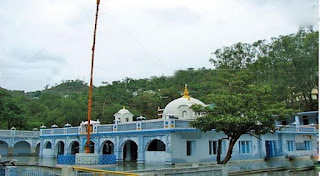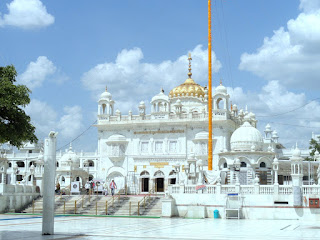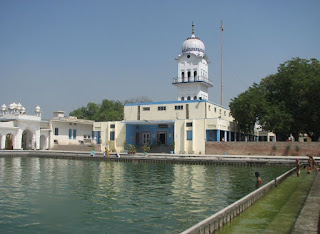Gurdwara Rawalsar Sahib
Gurdwara Rawalsar Sahib is located high on the hillside above the lake known as Rawalsar and the town that has grown up around its shores. Rawalsar (also spelled Rewalsar) is a town in the Mandi district in the Indian state of Himachal Pradesh about about 15-25Km west of Mandi.
Guru Gobind Singh visited the site once on the occasion of Baisakhi to meet with Raja Siddh Sen of Mandi and some other local hill chiefs to discuss their troubles with Aurangzeb. The Guru stayed at Rawalsar for a month.
A Gurdwara was constructed here by devotees of the Guru to perpetuate his memory. Adjoining the Gurdwara is a big tank, whose water has medicinal value. A dip in this tank is considered auspicious. The Gurdwara is built of stone and one can it by climbing 108 stairs. People visit this Shrine with great Devotion. It is a sacred place for Buddhists too. Many people from Tibet come here on pilgrimage, to pay homage to Buddhist Shrine situated here.
In 1930 Raja Joginder Sen of Mandi built the gurdwara to commemorate the Guru's visit. It is constructed of stone and one reaches it by climbing 108 stairs. The large sarovar (tank) attached to the Gurdwara is considered to have medicinal and currative properties. A dip in the tank is considered very auspicious. The Gurdwara is partiularly sacred to Namdhari Sikhs due to its mention in Sau Sakhi as a sanctuary.
Pilgrims of Buddhism and Hinduism also visit the area as there are many sites, shrines and mandirs related to the history of each religion in this area.
Located at an altitude of 1360 m above sea level in the Southern Himalayan belt, winters in Rawalsar can be freezing, but summers can be very pleasant.
In his “Mahankosh” (Panjabi encyclopaedia) Bhai Kahn Singh Nabha refers to Rawalsar as the place where Guru Gobind Singh ji addressed the hill rajas (in 1701). From gurdwara and open divaan stages, dhadhis and kavishars (folk singers and poets), including our father Giani Harchand Singh Bassian of Malaya, used to recite Guru Sahib’s revolutionary thunderous challenge to the assembled rajas in “parsang” (ballad) style.
The great historical significance of Rawalsar after Vaisakhi 1699, cannot be overstated.
Perhaps that is the reason why, like the revolutionary significance of Asa ki Vaar, which was heard daily in the villages of Punjab, the message of Rawalsar too has been incrementally forgotten through politically induced amnesia! To my mind Asa ki Vaar was open revolt against Brahmanic practices (the priest), and Rawalsar was revolution against oppression by the rulers (the king). Regrettably, the trend of Indian Sikhi under Hindutva influence, is to move away from the egalitarian independent Sikh thought and to even rewrite Sikh history. Today, many in India would like to believe that no one spoke of independence until the aimless and confused "Indian Mutiny" of 1857.
Bipran biased ritualism, worship and religious politics have taken over Sikh affairs. The “Encyclopaedia of Sikhism” by Patiala University does not even mention Rawalsar! (One senior parbandhak, responsible for Mandi and Rawalsar Gurdwaras was scathing about the attitude of our funding and publicity institutions when we visited the gurdwara.)
Guru Gobind Singh ji’s message of liberation and freedom from tyranny of Moghul rule, fell on the deaf ears of the hill rajas assembled at Rawalsar, about 15 miles from the town of Mandi in Himachal Pardesh. It is not too far north from Anandpur Sahib. That was two years after Vaisakhi 1699, when the Khalsa was revealed as Akal Purakh ki Fauj (Immortal Army of the Timeless).
The morally bankrupt pahari rajas (hill chiefs) were content to continue their lavish and lazy life styles at the expense of the poorest people in the land. Even today, despite massive subsidies by the comparatively less corrupt state government of Himachal Pardesh, and by the central government through various schemes and mega-water diversion and hydro-electricity projects, these hill people continue to scrounge around at subsistence level.
The rajas were content to pay tributes and taxes to the jihadi marauders over the mountains of the north-west frontier; and to present their daughters to the invaders at the border, while pleading with them to be spared. In the meantime, they were continually at each other’s throats. The Guru was often invited to settle their internal petty disputes.
Declaration of Guru ji’s intention to liberate the downtrodden people at Rawalsar in 1701, marked the start of the battles pre-Anandpur siege (May 1705), the great sacrifices including the four Sahibzaada, and 100 years Sikh war against all who stood against the Khalsa objective of establishment of a people’s kingdom, in which “no one inflicted pain on another” – the halemi raj predicted by Guru Arjan Dev ji (Shabad: “Hun Hukam hoa Mehrban da....”.
Every Sikh should visit Rawalsar and see the divine reflection of Guru Gobind Singh in the lake at Rawalsar. After all, unlike the mythological Hemkund, Guru Sahib did visit the sarovar, and himself saw the reflection of the future of those who would be his own “gareeb Sikhs” leading a people’s revolution as his Khalsa, to become the rulers of the land by the end of the 18th century.
Guru Gobind Singh visited the site once on the occasion of Baisakhi to meet with Raja Siddh Sen of Mandi and some other local hill chiefs to discuss their troubles with Aurangzeb. The Guru stayed at Rawalsar for a month.
A Gurdwara was constructed here by devotees of the Guru to perpetuate his memory. Adjoining the Gurdwara is a big tank, whose water has medicinal value. A dip in this tank is considered auspicious. The Gurdwara is built of stone and one can it by climbing 108 stairs. People visit this Shrine with great Devotion. It is a sacred place for Buddhists too. Many people from Tibet come here on pilgrimage, to pay homage to Buddhist Shrine situated here.
In 1930 Raja Joginder Sen of Mandi built the gurdwara to commemorate the Guru's visit. It is constructed of stone and one reaches it by climbing 108 stairs. The large sarovar (tank) attached to the Gurdwara is considered to have medicinal and currative properties. A dip in the tank is considered very auspicious. The Gurdwara is partiularly sacred to Namdhari Sikhs due to its mention in Sau Sakhi as a sanctuary.
Pilgrims of Buddhism and Hinduism also visit the area as there are many sites, shrines and mandirs related to the history of each religion in this area.
Located at an altitude of 1360 m above sea level in the Southern Himalayan belt, winters in Rawalsar can be freezing, but summers can be very pleasant.
In his “Mahankosh” (Panjabi encyclopaedia) Bhai Kahn Singh Nabha refers to Rawalsar as the place where Guru Gobind Singh ji addressed the hill rajas (in 1701). From gurdwara and open divaan stages, dhadhis and kavishars (folk singers and poets), including our father Giani Harchand Singh Bassian of Malaya, used to recite Guru Sahib’s revolutionary thunderous challenge to the assembled rajas in “parsang” (ballad) style.
The great historical significance of Rawalsar after Vaisakhi 1699, cannot be overstated.
Perhaps that is the reason why, like the revolutionary significance of Asa ki Vaar, which was heard daily in the villages of Punjab, the message of Rawalsar too has been incrementally forgotten through politically induced amnesia! To my mind Asa ki Vaar was open revolt against Brahmanic practices (the priest), and Rawalsar was revolution against oppression by the rulers (the king). Regrettably, the trend of Indian Sikhi under Hindutva influence, is to move away from the egalitarian independent Sikh thought and to even rewrite Sikh history. Today, many in India would like to believe that no one spoke of independence until the aimless and confused "Indian Mutiny" of 1857.
Bipran biased ritualism, worship and religious politics have taken over Sikh affairs. The “Encyclopaedia of Sikhism” by Patiala University does not even mention Rawalsar! (One senior parbandhak, responsible for Mandi and Rawalsar Gurdwaras was scathing about the attitude of our funding and publicity institutions when we visited the gurdwara.)
Guru Gobind Singh ji’s message of liberation and freedom from tyranny of Moghul rule, fell on the deaf ears of the hill rajas assembled at Rawalsar, about 15 miles from the town of Mandi in Himachal Pardesh. It is not too far north from Anandpur Sahib. That was two years after Vaisakhi 1699, when the Khalsa was revealed as Akal Purakh ki Fauj (Immortal Army of the Timeless).
The morally bankrupt pahari rajas (hill chiefs) were content to continue their lavish and lazy life styles at the expense of the poorest people in the land. Even today, despite massive subsidies by the comparatively less corrupt state government of Himachal Pardesh, and by the central government through various schemes and mega-water diversion and hydro-electricity projects, these hill people continue to scrounge around at subsistence level.
The rajas were content to pay tributes and taxes to the jihadi marauders over the mountains of the north-west frontier; and to present their daughters to the invaders at the border, while pleading with them to be spared. In the meantime, they were continually at each other’s throats. The Guru was often invited to settle their internal petty disputes.
Declaration of Guru ji’s intention to liberate the downtrodden people at Rawalsar in 1701, marked the start of the battles pre-Anandpur siege (May 1705), the great sacrifices including the four Sahibzaada, and 100 years Sikh war against all who stood against the Khalsa objective of establishment of a people’s kingdom, in which “no one inflicted pain on another” – the halemi raj predicted by Guru Arjan Dev ji (Shabad: “Hun Hukam hoa Mehrban da....”.
Every Sikh should visit Rawalsar and see the divine reflection of Guru Gobind Singh in the lake at Rawalsar. After all, unlike the mythological Hemkund, Guru Sahib did visit the sarovar, and himself saw the reflection of the future of those who would be his own “gareeb Sikhs” leading a people’s revolution as his Khalsa, to become the rulers of the land by the end of the 18th century.




Comments
Post a Comment